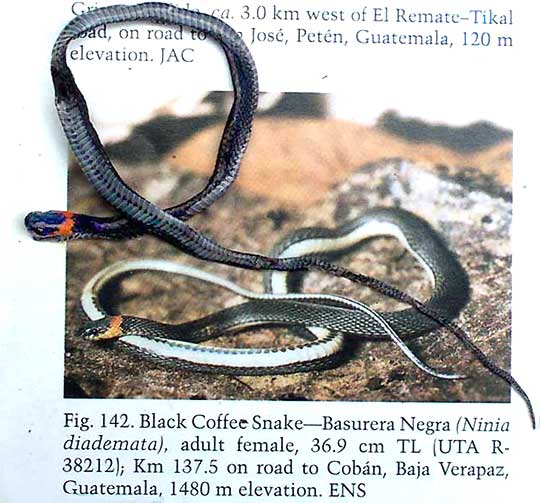Excerpts from Jim Conrad's
Naturalist Newsletter
from the November 19, 2007 Newsletter issued from Yerba Buena Clinic just outside Pueblo Nuevo Solistahuacan, Chiapas, MÉXICO
about 1740 meters in elevation, ± LAT. 17° 11' 27"N, LONG. -92° 53' 35"W
SQUASHED BLACK COFFEE-SNAKES
Jogging at dawn on Tuesday morning I almost stepped on an earthworm-size, car-flattened, blackish snake with an orange ring around his neck. It looked a lot like North America's Ringneck Snake, but not exactly. He wasn't too squishy so I slipped him into my pocket and carried him home with me.
I don't have a guide to the reptiles of Chiapas but I do still carry the wonderful book I used in the Yucatan, Jonathan A. Campbell's Amphibians and Reptiles of Northern Guatemala, the Yucatán, and Belize, published in 1988. In the illustration section I found a good match. A picture showing my roadkill specimen atop the book's photo I matched it with is shown below:

As you can see, the matching picture in the book is identified as the Black Coffee-Snake, NINIA DIADEMATA. The species is distributed from east-central Mexico to central Honduras, and in Guatemala it lives up to 1830 meters in elevation, so it should occur here. Campbell further says that the snake is secretive, usually hidden in abundant leaf litter or other ground cover where it feeds almost exclusively on slugs. When I hiked to town Thursday I found yet another Black Coffee-Snake, also run over by cars, so if this is a secretive species usually hidden in leaf litter, something must be causing them to roam right now.
Campbell provides fine identification keys so I set about "keying out" my roadkill to be more certain of its identification, especially because the white belly of the snake in the picture is whiter than mine. Working through the key I confirmed: Dorsal scale rows 19; anal scale entire; dorsal scales keeled; venter with a series of dark spots down middle... It keyed out exactly to Black Coffee Snake. Maybe the darker belly of our snakes is a local variation, or maybe the bellies of squashed coffee snakes just turn dark.
There's a Red Coffee-Snake, Ninia sebae, a coral-snake mimic, and it also should be found here.